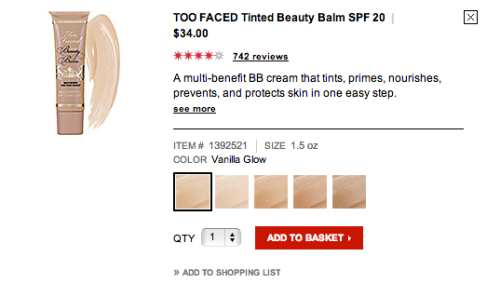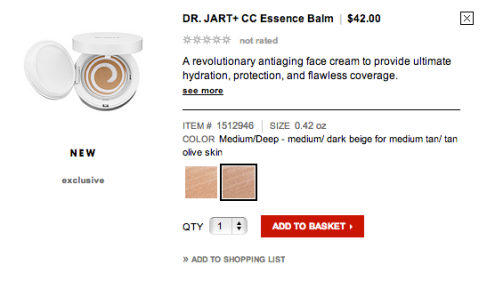The other day I was bopping around on the Internet checking my usual websites that I like to read. I clicked on Jezebel and the first article to come up was called “I’m a Black Woman and I Just Want Some Damn BB Cream”. I immediately started to read it as it seemed particularly relevant to our class and Kathy Peiss’ Hope In A Jar.
The article is written by a woman who is of mixed decent (her grandfather is Chinese and some of her other relatives are Nicaraguan, Jamaican, Spanish and Native American). The point of her article focuses on the fact that the beauty industry spends a large amount of time glossing over and clumping together people with darker skin tones. Trying to find the perfect shade of foundation or cover-up is a lot harder then for those with lighter toned skin. And yet, the beauty industry still spends a large amount of time trying to get their makeup to perfectly match white skin.
The new trend in makeup is something called a BB or a CC Cream, otherwise known as a blemish balm. These creams promote all in one facial correction so that you can replace your primer, foundation, sunblock, etc. with only one product. They originated in the 1960’s in Germany and is popular in Korea as it has certain skin whitening properties. The BB Cream craze in the United States only recently came to fruition in 2012 and now even has a line for men as well!
However, it seems like all the BB and CC creams out there are used for lighter skin toned people. The author, Sade Strehike, comments on how all the BB creams she has looked at only come in tones dark enough for a tanned white woman. However, she was so excited that she wore the cream anyways which resulted in stern scolding from her mother. Strehike says at one point in the article that, “MAC’s BB creams come in three shades, the darkest being “Light Plus.” What the hell is that?!? Who is “Light Plus” for? Certainly not for me”. This seemed ridiculous so I wanted to have a look for myself.
I decided to do a little research of my own on Sephora’s website of BB creams. She really wasn’t kidding. Almost all of the 35 products listed on the page range from colors such as “Linen Glow” to “Medium/Dark”. None of the shades look like anything past what a tanned white woman’s skin would look like after a summer spent in the sun. Even the shades listed as the darker shades have descriptions such as “medium/dark beige for medium tan/tan olive skin”. The only companies that carry dark enough shades to cater to deep skin tones are companies that cater specifically to black woman. These aren’t well advertised and are not widely available so it is hard to gage which product is best.
In Hope In A Jar, Peiss states that “ Cosmetics were never far removed from the fact of white supremacy” (Peiss, 203). It doesn’t seem like much has changed in terms of cosmetics since the 1920’s. Many other beauty products on Sephora’s website had a similar result in searches. Peiss says that “The democracy of mass-produced beauty still stopped short at the color line” (Peiss, 224). It seems it still does.
Peiss, Kathy. Hope in a Jar. Philadelphia: University of Pennsylvania Press, 1998. 147. Print.
http://jezebel.com/im-a-black-woman-and-i-just-want-a-damn-bb-cream-486149740)
http://www.sephora.com/bb-cc-cream-skincare?pageSize=-1
http://en.wikipedia.org/wiki/BB_cream


mollyburness
June 2, 2013 at 12:12 am
By combining individual types of makeup into this “all in one facial correction”, are people using BB cream more susceptible to losing the intentionality in their makeup application? Are they truly aware of the cream’s components and of what they are doing to their skin? In a sense, the consumer must always put his faith in the product company when applying makeup (or using medicine or wearing clothes or eating food, etc.). Although the product comes in close contact with the human body, the consumer does not make it himself. BB cream merely amplifies this concept of consumer-producer trust. Sure, there are laws and health codes that set basic guidelines for the producers, but beyond physical safety, the actual results of the makeup application are for the consumer to find out. I looked on the Sephora page that Mary Reagan referenced, and the information looked pretty clear. For example, many product pages included the following paragraph:
“Beauty Balms or B.B. Creams were originally developed as a perfect post-procedure cream used to treat, hydrate, prime, protect, and camouflage the skin. Great for all skin types including those with sensitive skin, these versatile “five-in-one” formulas are designed to do it all: treat with high levels of active skin care ingredients; moisturize and smooth dehydrated skin; prime and perfect skin’s surface; camouflage and color correct the skin tone; and protect skin from the sun with SPF. They can be used as a last step for their skincare benefits or used on their own as an instant beautifier.”
While Sephora does take the time to inform the consumers about the components of the product, I wonder how much consumers actually read this material. Is this useful or even desired information, or have consumers accepted their ignorance about the cosmetics they use? And is that even a problem?